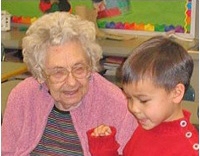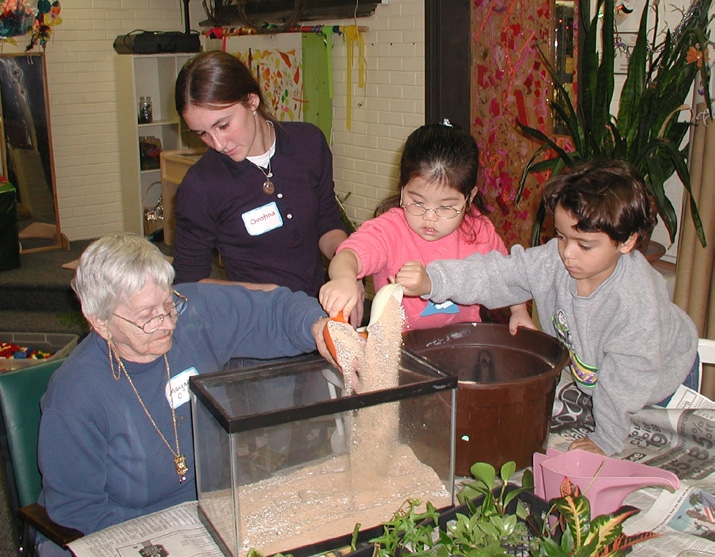Best Practices in Intergenerational Programming: Practice 5
ID
FCS-38P (FCS-82P)

Activities reflect interests, backgrounds, and social histories of program participants.
Practice 5 • Activities reflect interests
Intergenerational programs are most effective when the activities reflect the interests, backgrounds, and social histories of the program participants.
A social history is basically the accounting of an individual’s life — their interests, career, relationships, the ways they have coped, and how they have defined themselves. This primarily speaks to adult programs; however, many child programs are beginning to collect this information from parents regarding the children’s interests and family structures.
A social history, in turn, helps facilitators plan activities that build on interests. Such activities can lead to greater engagement, higher-order learning, and more positive experiences.
Furthermore, the elders are able to share their culture and traditions with the children. Participant diversity can be celebrated to enhance children’s pride in their heritage through incorporation of traditional music, art, dance, dress, food, and photos.
Application of the Practice
Consider combining older and younger participants at mealtimes to create a sense of family conversation. Prompt conversations that allow adults to share stories of the community in “olden times.”
When planning, use complementary pairing. For example, pair adults who can help with less-mature children; pair adults with diminished senses with more-alert children who could assist them. Cue each pair appropriately. Additional information about this is included in another fact sheet, Virginia Cooperative Extension publication FCS-40, “Best Practices in Intergenerational Programming: Practice 7.”
Some examples include:
- An elder who was a Navy cook can lead the children in an omelet- making activity.
- An elder who was a mail carrier can capitalize on the children’s interest in letters and writing.
- An elder who is knowledgeable about the outdoors and nature can lead an outdoor adventure and walk.
- Children and adults can learn to use computer tablets and cameras together.

Program Ideas
- Make activities relevant. Be sure the activities are intentional and diverse. Remember science, astronomy, reading, safety, music, games, movement and dance, storytelling, cooking, tinkering with tools, and more.
- Collect social history information from the families of adults and then review them for past hobbies — such as cooking, military, airplanes, woodworking, gardening, or office work — and build on those interests to present learning ideas to children. Identifying, naming, grouping, and other developmental concepts can be introduced to children using adult skill areas.
- Make a summary list of interests to post in the learning space for quick reference.
- Present photos of various activities to adults and children to assess their interest.
- Take photographs of participants involved in activities. Reflect with co-teachers on what seems to work best when planning new activities.
Best Practices for Intergenerational Programming
- Staff members of the adult and child programs collaborate to plan activities.
- Participants are involved in decision-making about the activity and during activities.
- Participation is voluntary.
- Participants are prepared ahead of time and reflect on the activity afterward.
- Activities reflect interests, backgrounds, and social histories of program participants.
- Activities are age- and role-appropriate.
- Activities support interaction among intergenerational participants.
- Facilitators skillfully stage the environment to promote interaction.
- Facilitators consider the social environment and the role of staff members.
- Adaptive equipment is used as appropriate.
- Facilitators document and communicate experiences to build on in future activities.
Additional Resource
Reed, J., and C. Koliba. 2012. Facilitating Reflection: A Manual for Leaders and Educators.
John Dewey Project. University of Vermont. www.uvm.edu/~dewey/reflection_manual/.
Reference
Jarrott, S. E. 2011. “Where Have We Been and Where Are We Going? Content Analysis of Evaluation Research of Intergenerational Programs.” Journal of Intergenerational Relationships 9:37-52. doi:10.1080/15350770.2011.544594.
Project TRIP
Transforming Relationships Through Intergenerational Programming
A Children’s, Youth, and Families at Risk project of Virginia Tech with the Jeerson Area Board for Aging and the YMCAs of Charlottesville and Louisa County, Va.
Shannon Jarrott, Associate Professor, Human Development, Virginia Tech
Karen DeBord, Extension Specialist, Family and Human Development, Virginia Tech
Reviewed by Crystal Tyler-Mackey, Extension Specialist, Community viability, Virginia Tech
Contact: Shannon Jarrott, sjarrott@vt.edu
This is one of 11 fact sheets on the emerging best practices associated with intergenerational programs.
Intergenerational programs are those that connect younger and older generations to foster positive experiences. Research continues to grow, noting that when successfully delivered, intergenerational programs result in positive health eects, child learning, and appropriate socialization for both young and old (Jarrott 2011).
The fifth practice relates to choosing activities that are relevant to the participants.
Virginia Cooperative Extension materials are available for public use, reprint, or citation without further permission, provided the use includes credit to the author and to Virginia Cooperative Extension, Virginia Tech, and Virginia State University.
Virginia Cooperative Extension is a partnership of Virginia Tech, Virginia State University, the U.S. Department of Agriculture (USDA), and local governments, and is an equal opportunity employer. For the full non-discrimination statement, please visit ext.vt.edu/accessibility.
Publication Date
May 1, 2019



